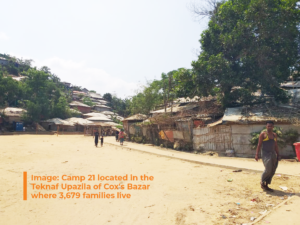
Two decades back, Market Systems Development (MSD), or Making Markets Work for the Poor (M4P) as it was called, was mostly confined to income and employment-related projects and focused on agricultural and industrial markets and value chains. However, it is now being applied in a wide range of sectors and systems – health, skills, humanitarian response, climate resilience, financial inclusion, WASH, nutrition, and in a wide range of contexts- fragile markets, conflict-affected territories.
As we expanded the scope for implementation of MSD programmes from matured markets to thin markets, it became evident that a private sector-centric lens to systems change has its limitations, especially in fragile contexts and in thin markets. We needed to critically review the scope and look beyond the private sector to facilitate systemic change in different types of crises – rapid on-set, conflict-related, and protracted. Practitioners coined the term hybrid market systems development in an attempt to explain that in such contexts, both direct and indirect interventions are essential.
In my two decades of experience in working with a range of market systems development projects in a wide variety of sectors, I observed closely how direct and indirect interventions, if put together, can bring about systemic change in fragile contexts, and in thin markets in Bangladesh, Indonesia, Mozambique, Myanmar, Nigeria, Somalia, Sri Lanka, and Yemen. I have learned some key lessons that I believe can help projects become more relevant, cost-effective, efficient, impactful, and sustainable.
1. Core vs supporting markets and rules: In MSD we analyze the core and seek to explain (under) performance in terms of support functions and rules. To facilitate improved performance of the system, the interventions primarily focus on support functions and rules. However, in thin markets, the core- demand and supply remains fragmented and weak. The absence of a strong core means that there is not enough incentive for the support functions and rules to intervene in favor of the core. In crises and thin markets, we thus tend to intervene relatively heavily in the core market.

2. Hard vs soft infrastructure; direct vs indirect: Given the absence of a strong core, in crises, and in thin markets, there is a need to intervene heavily in the core. These interventions necessitate investment in cash, asset transfer, infrastructure development, and subsidized product distribution. We thus start with heavy engagement and gradually shift towards light touch market facilitation as the core gains the strength that is required for the support functions and rules to work in favor of the core. This approach is defined as the hybrid approach by some practitioners. We also use the push and pull approach to explain how the direct investment (push) in the core creates the economies of scale at which the support function can work in favor of them and pull them up in the formal economy as an enterprise.
3. Government, donors, IFIs, UN agencies, and projects are very much part of the system: If we do not acknowledge these agencies as part of the system, we fail to understand the complexity of fragile and thin markets. These agencies govern not only the policies but also the demand and supply for the key resources, products, and services and also the support functions. In thin markets, crisis situations, and humanitarian contexts, the weak core means that the donor and the government agencies intervene directly in the core. They also influence the rules and the delivery of the support services as the support service providers directly sell to the donors and the government instead of the core market. In Bangladesh, WFP is the largest institutional buyer for a start-up selling food and non-food essentials. The government agencies and donors are the largest institutional users of the MFS providers for the transfer of cash for social safety net. Understanding how the government and donors influence the core, rules, and support functions is essential while intervening in thin markets and crisis situations and also in the basic services market (health, education, skills, WASH, nutrition). Informing. Educating. Aligning. Influencing donor and government interest is essential for MSD programmes in crises and conflict contexts.
4. Taking a gradual/ long-term approach in influencing partner’s will and skill: In MSD, partners are the key agents for the systemic change. We want them to invest in the solution, scale the solution, and sustain it. To achieve this, we use co-funding principles to both test partner will (incentives) and skill (capacity). This can be a harder principle to apply in crisis contexts especially given the heavy influence of the government and the donors. My studies in Nigeria in providing direct subsidies to malaria commodities show that a long-term approach helped crowd in the local private sector with diversified products and value propositions. The findings helped the donors and the government to decide in favor of withdrawing price subsidies from artemisinin combination therapy.
5. Recurrent vs one-off: MSD is concerned with the sustainability of means as well as ends. In this context, we ask, whether the facilitation support needs to be recurrent or one-off. If recurrent we need to have a clear vision of sustainability post-intervention. As mentioned above often in crisis situations we’re marrying short-term vs long-term goals and hence recurrent vs one-off functions. Knowing the difference isn’t always easy in the midst of a crisis. We have observed that having an informed pathway and strategic approach that combines both recurrent and one-off solutions is essential in both fragile contexts and thin markets.
6. Large indirect outreach is not practical in fragile contexts or thin markets: Perhaps the biggest incentive for the donors to adapt market systems approach was the fact that we got large-scale outreach with limited project resources. The projects achieved value for money for the donors. While in matured sectors it is viable to achieve such outreach, it is not possible or practical in fragile contexts and thin markets. Projects in such markets have a defined number of target beneficiaries. The entry points are specific households. On the other hand, projects working in matured markets start with the sector-first approach. The assumption here is that the growth in the sector will eventually benefit the poor who are connected or who can enter the sector. Here the beneficiaries are unknown. Given this difference in entry point, it is not possible for projects in thin markets to get large indirect outreach.
7. Markets change and evolve; no intervention or solution will sustain in the long run; we need to measure whether our interventions have resulted successful pivots: This condition is relevant for all contexts. The competitive environments are such that no solution will sustain in the long run at its core. The project’s true impact is on the degree to which it has contributed to successful pivots by partners and market forces. The framework to observe the pivots is there on the Adopt-Adapt-Expand-Respond framework to measure systemic change. However, it does become complex to understand these changes and the pivots that are quite organic. To address this challenge, it is important to continuously track the economic shifts and movements and observe how these can be connected to the project. For example, a project that worked on financial inclusion can assess whether the households that were targeted were better able to withstand a particular economic shock or a natural shock. The project can also assess whether the partner organizations performed better in such conditions.
8. Finally, a four-year project in a fragile market is too short to facilitate systems change: I understand that the donors have priorities and it is often not possible to commit to long term interventions. Typically, donors have opted for four- or five-year projects. Yet, if you look at some of the most successful market systems interventions, you will observe that they have lasted for several phases. These projects were also not implemented in fragile contexts or thin markets. It is impractical to target systemic change in a fragile market within a few years. In such contexts, humanitarian response and direct assistance is often the first priority as we need to stop escalation of the hostile environment and the negative impact on the target beneficiaries resulting from the crises. For instance, for a project working on malaria elimination, the priority is to stop deaths due to malaria. If that requires direct distribution of antimalarials and rapid diagnostic test kits, then that should be the first intervention. Despite direct service delivery, projects that embrace a systemic lens at the heart will understand that it can shortly pivot to a systems-driven intervention as the immediate burden is reduced through direct delivery. A clever mix of short term direct interventions and long term indirect market facilitation interventions result the desired systemic change in such contexts.
Author: Md. Rubaiyath Sarwar, Managing Director, Innovision Consulting